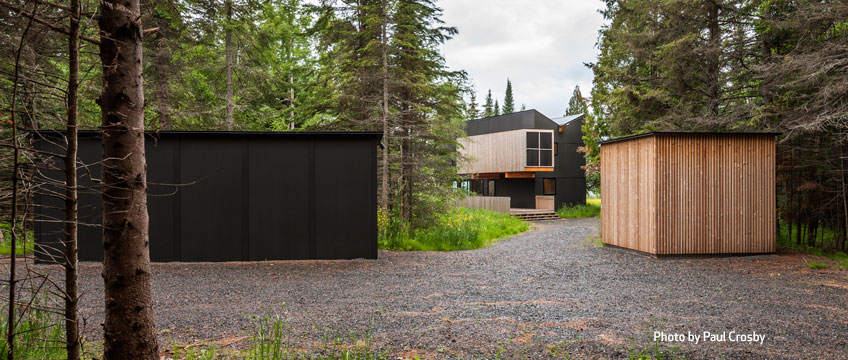An expectation-defying Lake Superior getaway stirs the imagination
By Thomas Fisher, Assoc. AIA
A new David Salmela–designed family retreat on Lake Superior’s south shore represents what the writer Nassim Nicholas Taleb calls a “black swan event.” The cabin looks a bit like a black swan, with the exterior clad in black Richlite, the uplifted wings of its butterfly roof, and the projecting necks of its scuppers. But the relevance of Taleb’s idea goes beyond the cabin’s appearance.
Black swan events go against our expectations, change our thinking, and prompt an explanation—and this building does all three. Instead of the typical gable-roofed cabin with screened porch, this one upends that model. In a climate where gutters present a maintenance problem, “a gable roof sheds water where you don’t want it, onto the deck,” says Salmela. So the architect inverted scissor trusses to direct water back to a center roof cricket, which moves the runoff to long spouts at either end.
And in a location where the sun’s warmth matters, “screened porches reduce the daylight into the house,” adds Salmela. That led him to cantilever the porch off the second floor, adjacent to the stair, which needs less light, and above the route to the front door, which now enjoys shelter from rain and snow. No longer worried about blocking light, Salmela designed the screened porch to maximize the comfort of those using it, with slats along the south side to provide shade and open ends to funnel the breeze off the lake.
That same contrary thinking continues inside. To reduce maintenance, he used slate floors with in-floor heat on the main level, locally sourced basswood paneling instead of painted drywall, and inexpensive melamine kitchen cabinets whose black color hides dirt well and “makes the views out the windows more dramatic,” says Salmela. Primary colors add to the drama. Upstairs, “the red doors and blue floor, which matches the color of the lake, compensate for the lack of painted walls,” he explains, “and the yellow stair risers and treads makes it easier for the children and guests to see at night if they need to use the main downstairs bathroom.”
The cabin also enhances seeing during the day. The open living/dining/kitchen space on the first floor has large windows framing the view of the gorgeous landscape outside, and the alignment of windows and doors on the second floor provides perspectives through the house despite the number of spaces—a master bedroom and bathroom, a guest room, and two bunkrooms. The V-shaped second-floor ceiling, echoing the butterfly roof above, also defies expectations, making small rooms feel larger. Even something as simple as a mirror-finished chimney, which rises through the master bedroom from the stove in the living room below, creates a constantly changing reflection as you move around it.
A different kind of reflection occurs outside, where the butterfly-roof sauna echoes the main house in miniature, the slat-sided woodshed recalls the much larger screened porch, and the black Richlite storage building resembles a blown-up version of the kitchen cabinets. The deck, longer than the house itself, feels as if another structure once stood there and left behind its concrete-block chimney and second-floor screened porch.
Such effects reveal something that too few people recognize: Talented designers like David Salmela constantly produce black swans that go against our expectations, change our view of things, and challenge us to explain them. Black swans emerge in response to specific circumstances, as in the case of this cabin. But once we experience them, they make us wonder why we didn’t see them before—and why anyone would want to go back to a world of only white ones.
FAMILY RETREAT
Location: Wisconsin
Architect: Salmela Architect
salmelaarchitect.com
Principal: David Salmela, FAIA
Project manager: David Getty
Structural engineer: Meyer Borgman Johnson
General contractor: Lake Effect Builders
Size: 1,280 square feet
Completion: June 2014
Photographer: Paul Crosby



